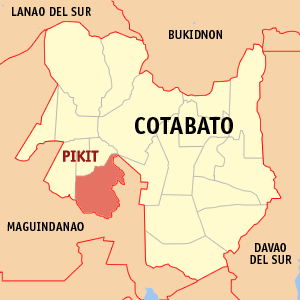Pikit

Pikit is a 1st class municipality in the province of Cotabato, Philippines. The so-called Pikit war between Muslim separatists and the Philippines army took place there in early 2003.
According to the 2000 census, it has a population of 68,455 people in 13,081 households.[1]
History
The name "Pikit" was given to the place by the Spaniards. It was formerly called by the natives "Malasiquit" because it was situated within the shadows of hills situated to each other.
Under the Osmeña Colony Act of 1912, Pikit was founded on June 17, 1913 by the first Christian Filipino Colonists from the Province of Cebu, About one hundred twenty Cebuanos came under the Colony Agent, Vicente Lozada, The first batch of colonists from Cebu arrived at Fort Pikit after two days of sailing on board a river boat called "Hall", followed the Rio Grande de Mindanao.
The very Rio Grande River where the colonists landed is now a corn field. It became dry land due to the cut-off river found in Kulanguan, Tunggol, Pagalungan, Maguindanao.
The first batch of colonists were distributed at Ladtingan, Calawag, Ginatilan, Panicupan, Manding and Inug-ug .They belonged to Colony No. 1
Other colonists followed in 1914 up to 1915 and they were assigned in the following colonies, Colony No. 2 (Paidu Pulangi) Colony no. 3 (Silik) Colony No. 4 (Makasendeg) Colony No. 5 (Pagalungan) and Colony No.7 (Talitay).
Those who came in 1918 from the Visayas and Luzon were called homeseekers, immigrants, and settlers because the government did not give them anymore free transportation and ration in their coming.
During the Colony days the Colonies had a special government under the administration of the Colony Superintendent; Mr. Maximo Abad was then appointed. Mr. Miguel Jacosalem, Asst. Supt. for Colony No. 3, Datu Abdula Piang, Asst. Supt. for Colony No. 3, Mr. Tuan Afdal, Asst. Supt. for Colony No. 4, Mr. Ruperto Gemarino, Asst. Supt. for Colony No. 5 and Mr. Primo Curo, Astt. Supt. for Colony No. 7
Schools were opened in the Colonies. The first school opened was Ladtingan which James E. McCall was assigned as Supervisor. The first teachers were Frucosa Lucero and Ponciana Lucero.
In 1924, the colonists began to fight for the townsite and local autonomy, for the creation of Pikit into a regular municipality.
In 1928, the Colony Administration was turned over to the Bureau of Lands. Pikit was created a Municipal District, including the new municipality of Pagalungan.
In 1935, the construction of the Cotabato-Davao national Highway helped enhance the progress of this town. This road passes through the heart of Pikit. It afforded a faster and more convenient means of transportation and shipment of farm products.
In the early part of 1947 this Municipal District was created into a regular municipality, as the Municipality of Pagalungan and Pikit as a barrio, Mr. Gorgonio P. Initan was the first appointed mayor who was also the first elected mayor because this year was also the election of the municipal officials. The seat of Government was in Pagalungan.
On May 9, 1948, the Barrio Planning Personnel accompanied by Atty. Sergio F. Tocao, came to Pikit. This marked the triumph of the colonists for the establishment of Manding as a townsite.
In Sept. 29, 1949, Pikit was created a regular municipality by Executive Proclamation with Manding as the seat of the municipal government. This ended the struggle of the colonists and marked the fulfillment of their aspirations. Pikit was created out of the municipality of Pagalungan.
Pikit was proclaimed into a regular municipality thru the efforts of the late Congressman Gumbay Piang and Governor Duma Sinsuat by virtue of Executive Order No. 270 with its townsite at Manding .
Barangays
Pikit is politically subdivided into 42 barangays.
|
|
|
References
External links
